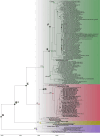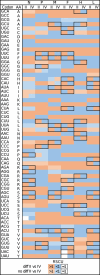Comparative evolutionary analyses of peste des petits ruminants virus genetic lineages
- PMID: 38476867
- PMCID: PMC10930206
- DOI: 10.1093/ve/veae012
Comparative evolutionary analyses of peste des petits ruminants virus genetic lineages
Abstract
Peste des petits ruminants virus (PPRV) causes a highly infectious disease affecting mainly goats and sheep in large parts of Africa, Asia, and the Middle East and has an important impact on the global economy and food security. Full genome sequencing of PPRV strains has proved to be critical to increasing our understanding of PPR epidemiology and to inform the ongoing global efforts for its eradication. However, the number of full PPRV genomes published is still limited and with a heavy bias towards recent samples and genetic Lineage IV (LIV), which is only one of the four existing PPRV lineages. Here, we generated genome sequences for twenty-five recent (2010-6) and seven historical (1972-99) PPRV samples, focusing mainly on Lineage II (LII) in West Africa. This provided the first opportunity to compare the evolutionary pressures and history between the globally dominant PPRV genetic LIV and LII, which is endemic in West Africa. Phylogenomic analysis showed that the relationship between PPRV LII strains was complex and supported the extensive transboundary circulation of the virus within West Africa. In contrast, LIV sequences were clearly separated per region, with strains from West and Central Africa branched as a sister clade to all other LIV sequences, suggesting that this lineage also has an African origin. Estimates of the time to the most recent common ancestor place the divergence of modern LII and LIV strains in the 1960s-80s, suggesting that this period was particularly important for the diversification and spread of PPRV globally. Phylogenetic relationships among historical samples from LI, LII, and LIII and with more recent samples point towards a high genetic diversity for all these lineages in Africa until the 1970s-80s and possible bottleneck events shaping PPRV's evolution during this period. Molecular evolution analyses show that strains belonging to LII and LIV have evolved under different selection pressures. Differences in codon usage and adaptative selection pressures were observed in all viral genes between the two lineages. Our results confirm that comparative genomic analyses can provide new insights into PPRV's evolutionary history and molecular epidemiology. However, PPRV genome sequencing efforts must be ramped up to increase the resolution of such studies for their use in the development of efficient PPR control and surveillance strategies.
Keywords: endemic; epizootic; evolution; morbillivirus; phylogenetics; small ruminants.
© The Author(s) 2024. Published by Oxford University Press.
Conflict of interest statement
None declared.
Figures





Similar articles
-
First genetic characterization of Peste des Petits Ruminants from Niger: On the advancing front of the Asian virus lineage.Transbound Emerg Dis. 2018 Oct;65(5):1145-1151. doi: 10.1111/tbed.12901. Epub 2018 Jul 25. Transbound Emerg Dis. 2018. PMID: 30043436
-
Persistence of the historical lineage I of West Africa against the ongoing spread of the Asian lineage of peste des petits ruminants virus.Transbound Emerg Dis. 2021 Nov;68(6):3107-3113. doi: 10.1111/tbed.14066. Epub 2021 Mar 23. Transbound Emerg Dis. 2021. PMID: 33704888 Free PMC article.
-
Genome sequencing of an Indian peste des petits ruminants virus isolate, Izatnagar/94, and its implications for virus diversity, divergence and phylogeography.Arch Virol. 2017 Jun;162(6):1677-1693. doi: 10.1007/s00705-017-3288-2. Epub 2017 Feb 28. Arch Virol. 2017. PMID: 28247095
-
Review of Peste des Petits Ruminants Occurrence and Spread in Tanzania.Animals (Basel). 2021 Jun 7;11(6):1698. doi: 10.3390/ani11061698. Animals (Basel). 2021. PMID: 34200290 Free PMC article. Review.
-
Future research to underpin successful peste des petits ruminants virus (PPRV) eradication.J Gen Virol. 2017 Nov;98(11):2635-2644. doi: 10.1099/jgv.0.000944. Epub 2017 Oct 12. J Gen Virol. 2017. PMID: 29022862 Free PMC article. Review.
Cited by
-
Molecular characterization of peste des petits ruminants virus and Mycoplasma capricolum subsp. capripneumoniae in small ruminants in northern Mauritania, 2023.Vet Res Commun. 2024 Dec;48(6):4089-4095. doi: 10.1007/s11259-024-10527-5. Epub 2024 Sep 3. Vet Res Commun. 2024. PMID: 39225972
-
The inhibitory and anti-inflammatory effects of TMP269 on peste des petits ruminants virus replication.Virulence. 2025 Dec;16(1):2495838. doi: 10.1080/21505594.2025.2495838. Epub 2025 Apr 24. Virulence. 2025. PMID: 40275702 Free PMC article.
References
-
- Banyard A. C. et al. (2010) ‘Global Distribution of Peste Des Petits Ruminants Virus and Prospects for Improved Diagnosis and Control’, Journal of General Virology, 91: 2885–97. - PubMed
-
- Baron M. D. et al. (2016) ‘Peste Des Petits Ruminants Virus’, in Kielian, M., Maramorosch, K. and Mettenleiter, T. C. (eds) Advances in Virus Research Volume 95, pp. 1–42. Cambridge/Massachusetts/USA: Academic Press. - PubMed
LinkOut - more resources
Full Text Sources

